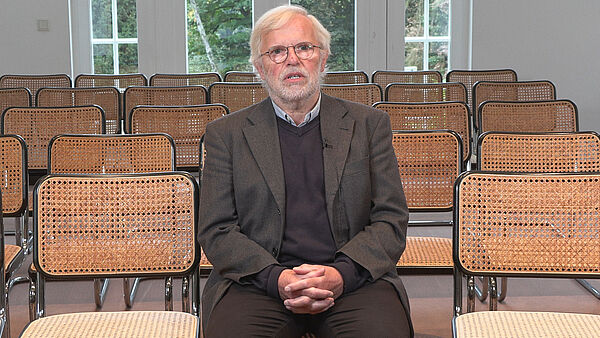
Reimer Kühn, Dr. rer. nat.
Professor of Statistical Physics (Emeritus)
King’s College London
Born in 1955 in Glückstadt, Germany
Diploma in Physics, Christian-Albrechts Universität zu Kiel and the University of Sussex, Dr. rer. nat., Christian-Albrechts Universität zu Kiel
Arbeitsvorhaben
From Neurons to Brains— from Societies of Brains to Brains of Societies
In my project, I will analyze collective information processing in and of societies. I will explore to which extent a neural network analogy can provide useful concepts and guiding principles for such an analysis, and whether it could help rationalize important structural and dynamic properties of societies. Key observations underlying the analogy are that neurons in a brain, like members of a society, communicate with each other, and that they evaluate received information to determine their (re-)action in a given communicative or situate context. Evaluations are, moreover, adapted in the process, entailing that responses and actions are not hard-wired. Neural networks, like societies, therefore constitute adaptive collective information processing systems, with information processing capabilities transcending those of their constituent elements. Key predictions of the analogy include (i) the stability of macroscopic properties of societies, thus a possible rationalization of the emergence of a stable spectrum of agreed norms, rituals, and dominant intellectual paradigms, which may, however, evolve on long time scales and even undergo rare spontaneous major disruptions analogous to phase transitions, (ii) the existence of fundamental limitations of information-processing capabilities, (iii) along with that, a degradation of the adaptability of societies as they increase the number and complexity of the processes they attempt to support, and (iv) a hierarchical de-differentiation of societies as generic response to major crises. The purpose of my fellowship at the Wissenschaftskolleg is to elaborate the predictions that suggest themselves through the neural network analogy and to try testing them against (i) historical studies of societies over longer time horizons, specifically concerning the dynamics and phenomenology of major transformations and crises, (ii) the history of law and economics, (iii) insights of evolutionary biology and anthropology, and (iv) existing sociological theories.Recommended Reading
Kühn, Reimer R., and Uta Horstmann (1997). “Random Matrix Approach to Glassy Physics: Low Temperatures and Beyond.” Physical Review Letters 78: 4067–4070. https://doi.org/10.1103/PhysRevLett.78.4067.
Kühn, Reimer (2008). “Spectra of Sparse Random Matrices.” Journal of Physics A 41: 295002. https://doi.org/10.1088/1751-8113/41/29/295002.
Anand, Kartik, Jonathan Khedair, and Reimer Kühn (2018). “A Structural Model for Fluctuations in Financial Markets.” Physical Review E 97: 052312. https://doi.org/10.1103/PhysRevE.97.052312.
Kolloquium, 15.10.2025
From Neurons to Brains – from Societies of Brains to Brains of Societies
In this talk, I will describe how neurons in a brain process information. I will begin with a description of single neurons and what they do – in essence collect and evaluate information coming from many sources and relay a kind of summary to other neurons they project to. From there I will proceed to the capabilities of networks of neurons. According to current understanding, the learning in or training of neural networks happens through modification of synaptic strengths, including growing new synapses and deleting existing ones. I will describe a way of looking at learning in neural networks that allows one to discuss the fundamental limits of information processing capabilities of networks of a given architecture.
Looking at members of a society, we realize that their communication works along similar principles. They evaluate received information to determine their (re-)action in a given communicative or situational context. As with neurons, evaluations are adapted in the process, by experience or training, entailing that responses and actions are not hard-wired. Neural networks, like societies, therefore, constitute adaptive collective information processing systems, with information processing capabilities genuinely located in the connections and transcending those of their constituent elements.
I will describe some of the key predictions of this analogy. They include in particular the stability of macroscopic properties of societies, thus a possible rationalization of the emergence of a stable spectrum of agreed norms, rituals, and dominant intellectual paradigms. Stability is not absolute though. Collective states do evolve over longer time scales and may even undergo rare spontaneous major transformations analogous to phase transitions. The general pattern of evolution of societies over long time scales could thus be described as evolution through punctuated equilibria.
The second major topic I will discuss is whether the prediction concerning the existence of fundamental limitations of information processing capabilities will hold when applied to societies. Consequences of the existence of such limits would include for instance a degradation of the adaptability of societies as they increase the number and complexity of the processes they attempt to support, and a hierarchical de-differentiation of societies as a generic response to major crises. I will try to give historical examples in support of that idea.
Publikationen aus der Fellowbibliothek
Kühn, Reimer (Amsterdam, 2021)
Kühn, Reimer (Woodbury, NY, 2018)
Structural model for fluctuations in financial markets
Kühn, Reimer (Berlin, 2015)
Stability, emergence and part-whole-reduction
Kühn, Reimer (Orlando, Fla, 2014)
Kühn, Reimer (Bristol, 2008)
Spectra of sparse random matrices
Kühn, Reimer (Berlin, 2007)
Learning with incomplete information and the mathematical structure behind it
Kühn, Reimer (Berlin, 2003)
Adaptivity and learning : an interdisciplinary debate Physics and astronomy online library
Kühn, Reimer (College Park, Md., 1997)
Random matrix approach to glassy physics : low temperatures and beyond
Kühn, Reimer (Bristol, 1993)
Statistical mechanics for neural networks with continuous-time dynamics
